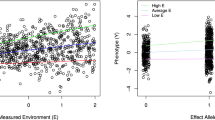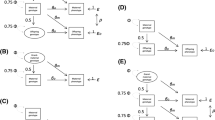Abstract
Gene–environment interaction (G × E) has been treated as both a statistical phenomenon and a biological reality. It is argued that, although there are important statistical issues that need to be considered, the focus has to be on the biological implications of G × E. Four reports of G × E deriving from the Dunedin longitudinal study are used as exemplars of the biological considerations that should lead to an hypothesis-driven choice of the specific genetic polymorphisms and the specific environmental influence to be investigated. The same four studies are used to discuss how the assessment of internal and external validity can be undertaken and how experimental approaches in humans and with animal models may be informative in the elucidation of the relevant operative biological mechanisms.
Similar content being viewed by others
References
Academy of Medical Sciences (2007). Identifying the environmental causes of disease: how should we decide what to believe and when to take action?. London: Academy of Medical Sciences.
Adamo, K. B., & Tesson, F. (2008). Gene–environment interaction and the metabolic syndrome. In M. Rutter (Ed.), Gene effects on environmental vulnerability to disease (pp. 103–127). Chichester: Wiley.
Battaglia, M., Marino, C., Maziade, M., Molteni, M., & D’Amato, F. (2008). Gene–environment interaction and behavioral disorders: a developmental perspective based on endophenotypes. In M. Rutter (Ed.), Gene effects on environmental vulnerability to disease (pp. 31–47). Chichester: Wiley.
Bird, A. (2007). Perceptions of epigenetics. Nature, 447, 396–398.
Caspi, A., McClay, J., Moffitt, T. E., Mill, J., Martin, J., Craig, I. W., et al. (2002). Role of genotype in the cycle of violence in maltreated children. Science, 297, 851–854.
Caspi, A., & Moffitt, T. E. (2006). Gene–environment interactions in psychiatry: joining forces with neuroscience. Nature Reviews Neuroscience, 7, 583–590.
Caspi, A., Moffitt, T. E., Cannon, M., McClay, J., Murray, R., Harrington, H., et al. (2005). Moderation of the effect of adolescent-onset cannabis use on adult psychosis by a functional polymorphism in the catechol-O-methyltransferase gene: longitudinal evidence of a gene X environment interaction. Biological Psychiatry, 57, 1117–1127.
Caspi, A., Sugden, K., Moffitt, T. E., Taylor, A., Craig, I. W., Harrington, H., et al. (2003). Influence of life stress on depression: moderation by a polymorphism in the 5-HTT gene. Science, 301, 386–389.
Caspi, A., Williams, B., Kim-Cohen, J., Craig, I. W., Milne, B. J., Poulton, R., et al. (2007). Moderation of breastfeeding effects on the IQ by genetic variation in fatty acid metabolism. Proceedings of the National Academy of Science U S A, 104, 18860–18865.
Eaves, L. J. (2006). Genotype x Environment interaction in psychopathology: fact or artifact? Twin Research and Human Genetics, 9, 1–8.
Hariri, A. R., Drabant, E. M., Munoz, K. E., Kolachana, B. S., Mattay, V. S., Egan, M. F., et al. (2005). A susceptibility gene for affective disorders and the response of the human amygdala. Archives of General Psychiatry, 62, 146–152.
Hariri, A. R., Mattay, V. S., Tessitore, A., Kolachana, B., Fera, F., Goldman, D., et al. (2002). Serotonin transporter genetic variation and the response of the human amygdala. Science, 297, 400–403.
Henquet, C., Rosa, A., Krabbendam, L., Papiol, S., Fananás, L., Drukker, M., et al. (2006). An experimental study of catechol-o-methyltransferase Val158Met moderation of delta-9-tetrahydrocannabinol-induced effects on psychosis and cognition. Neuropsychopharmacology, 31, 2748–2757.
Kim-Cohen, J., Caspi, A., Taylor, A., Williams, B., Newcombe, R., Craig, I. W., et al. (2006). MAOA, maltreatment, and gene–environment interaction predicting children’s mental health: New evidence and a meta-analysis. Molecular Psychiatry, 11, 903–913.
Meaney, M. J., & Szyf, M. (2005). Environmental programming of stress responses through DNA methylation: Life at the interface between a dynamic environment and a fixed genome. Dialogues in Clinical Neuroscience, 7, 103–123.
Meyer-Lindenberg, A., Buckholtz, J. W., Kolachana, B. R., Hariri, A., Pezawas, L., Blasi, G., et al. (2006). Neural mechanisms of genetic risk for impulsivity and violence in humans. Proceedings of the National Academy of Sciences U S A, 103, 6269–6274.
Mill, J., & Petronis, A. (2007). Molecular studies of major depressive disorder: the epigenetic perspective. Molecular Psychiatry, 12, 799–814.
Moffitt, T. E., Caspi, A., Rutter, M., & Silva, P. A. (2001). Sex differences in antisocial behavior: conduct disorder, delinquency, and violence in the Dunedin longitudinal study. Cambridge, UK: Cambridge University Press.
Pezawas, L., Meyer-Lindenberg, A., Drabant, E. M., Verchinski, B. A., Munoz, K. E., Kolachana, B. S., et al. (2005). 5-HTTLPR polymorphism impacts human cingulated–amygdala interactions: a genetic susceptibility mechanism for depression. Nature Neuroscience, 8, 828–834.
Rutter, M. (2006a). Genes and behavior: nature–nurture interplay explained. Oxford: Blackwell.
Rutter, M. (2006b). Implications of resilience concepts for scientific understanding. Annals of the New York Academy of Sciences, 1094, 1–12.
Rutter, M. (2006c). The psychological effects of early institutional rearing. In P. Marshall, & N. Fox (Eds.), The development of social engagement: neurobiological perspectives (pp. 355–391). New York & Oxford: Oxford University Press.
Rutter, M. (2007). Gene–environment interdependence. Developmental Science, 10, 12–18.
Rutter, M. (Ed.) (2008a). Introduction: whither gene–environment interactions? In Genetic effects on environmental vulnerability (pp. 1–12). Chichester, Wiley.
Rutter, M. (Ed.) (2008b). Conclusions: taking stock and looking ahead. In Gene effects on environmental vulnerability to disease (pp. 198–205). Chichester: Wiley.
Rutter, M., Beckett, C., Castle, J., Colvert, E., Kreppner, J., Mehta, M., et al. (2007). Effects of profound early institutional deprivation: an overview of findings from a UK longitudinal study of Romanian adoptees. European Journal of Developmental Psychology, 4, 332–350.
Rutter, M., Caspi, A., & Moffitt, T. E. (2003). Using sex differences in psychopathology to study causal mechanisms: unifying issues and research strategies. Journal of Child Psychology and Psychiatry, 44, 1092–1115.
Rutter, M., Hagel, A., & Giller, H. (1998). Anti-social behaviour and young people. Cambridge: Cambridge University Press.
Rutter, M., & Pickles, A. (1991). Person–environment interactions; concepts, mechanisms, and implications for data analysis. In T. D. Wachs, & R. Plomin (Eds.), Conceptualization and measurement of organism–environment interaction (pp. 105–141). Washington DC: APA.
Snieder, H., Wang, X., Lagou, V., Penninx, B. W. J. H., Riese, H., & Hartman, C. A. (2008). Role of gene–stress interactions in gene finding studies. In M. Rutter (Ed.), Gene effects on environmental vulnerability to disease (pp. 71–86). Chichester: Wiley.
Sonuga-Barke, E. J. S., Beckett, C., Kreppner, J., Castle, J., Colvert, E., Stevens, S., et al. (2008). Is subnutrition necessary for a poor outcome following severe and pervasive early institutional deprivation? Brain growth, cognition and mental health. Developmental Medicine and Child Neurology, in press.
Tabery, J. (2007). Biometric and developmental gene–environment interactions: looking back, moving forward. Development and Psychopathology, 19, 961–976.
Taylor, A., & Kim-Cohen, J. (2007). Meta-analysis of gene–environment interactions in developmental psychopathology. Development and Psychopathology, 19, 1029–1037.
Uher, R. (2008). Gene–environment interaction: Overcoming methodological challenges. In M. Rutter (Ed.), Gene effects on environmental vulnerability to disease (pp. 13–30). Chichester: Wiley.
Wray, N. R., Coventry, W. L., James, M. R., Montgomery, G. W., Eaves, L. J., & Martin, N. G. (2008). Use of monozygotic twins to investigate the relationship between 5-HTTLPR genotype, depression and stressful life events: an application of Item Response Theory. In M. Rutter (Ed.),Gene effects on environmental vulnerability to disease (pp. 48–67). Chichester: Wiley.
Author information
Authors and Affiliations
Corresponding author
Rights and permissions
About this article
Cite this article
Rutter, M. Biological Implications of Gene–Environment Interaction. J Abnorm Child Psychol 36, 969–975 (2008). https://doi.org/10.1007/s10802-008-9256-2
Published:
Issue Date:
DOI: https://doi.org/10.1007/s10802-008-9256-2




